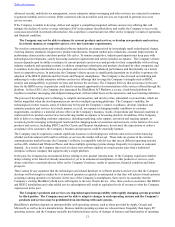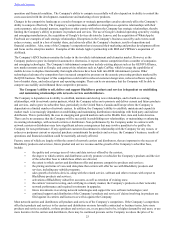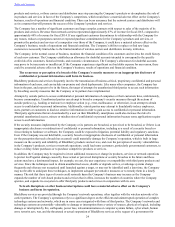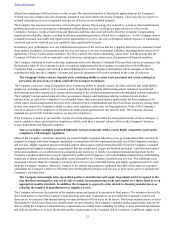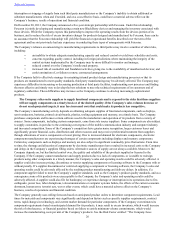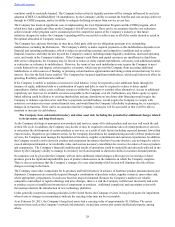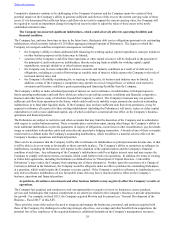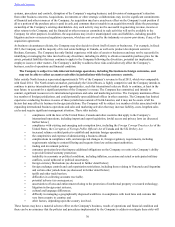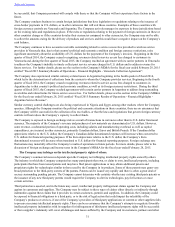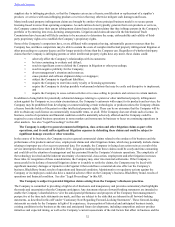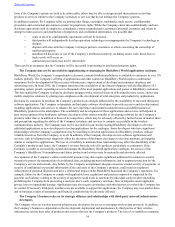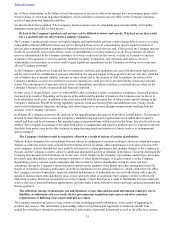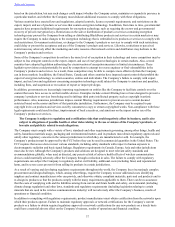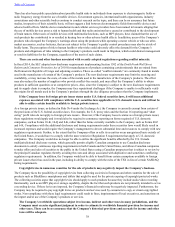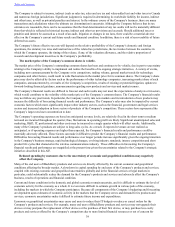Blackberry 2015 Annual Report Download - page 38
Download and view the complete annual report
Please find page 38 of the 2015 Blackberry annual report below. You can navigate through the pages in the report by either clicking on the pages listed below, or by using the keyword search tool below to find specific information within the annual report.
Table of Contents
29
Competitive dynamics continue to be challenging to the Company’s business and the Company cannot be certain of their
potential impact on the Company’s ability to generate sufficient cash flows to fully recover the current carrying value of these
assets. If it is determined that sufficient future cash flows do not exist to support the current carrying value, the Company will
be required to record an impairment charge for long-lived assets in order to adjust the value of these assets to the newly
established estimated value.
The Company has incurred significant indebtedness, which could adversely affect its operating flexibility and
financial condition.
The Company has, and may from time to time in the future have, third-party debt service obligations pursuant to its outstanding
indebtedness, which currently includes $1.25 billion aggregate principal amount of Debentures. The degree to which the
Company is leveraged could have important consequences, including:
• the Company’s ability to obtain additional debt financing for working capital, capital expenditures, strategic initiatives
or other business purposes in the future may be limited;
• a portion of the Company’s cash flow from operations or other capital resources will be dedicated to the payment of
the principal of, and/or interest on, indebtedness, thereby reducing funds available for working capital, capital
expenditures, strategic initiatives or other business purposes;
• the Company may be more vulnerable to adverse economic and industry conditions as a result of its debt service
obligations, including as a result of borrowings at variable rates of interest, which exposes the Company to the risk of
increased interest rates; and
• the Company’s flexibility in planning for, or reacting to changes in, its business and industry may be limited. In
addition, certain of the Company’s competitors may operate on a less leveraged basis, or without such restrictive
covenants and therefore could have greater generating and financing flexibility than the Company.
The Company’s ability to make scheduled payments of interest on, and to refinance, its indebtedness will depend upon its
future operating performance and cash flow, which are subject to prevailing economic conditions and financial, competitive,
business and other factors, many of which are beyond the Company’s control. The Company’s business may not generate
sufficient cash flow from operations in the future, which could result in its inability to pay amounts due under its outstanding
indebtedness or to fund other liquidity needs. If the Company does not have sufficient cash flow from operations, it may be
required to refinance all or part of its then existing indebtedness (including the Debentures), sell assets, reduce or delay capital
expenditures or seek to raise additional capital, any of which could have a material adverse effect on the Company’s business,
operations and financial position.
The Debentures are subject to restrictive and other covenants that may limit the discretion of the Company and its subsidiaries
with respect to certain business matters. These covenants place restrictions upon, among other things, the Company’s ability to
incur additional indebtedness or provide guarantees in respect of obligations, create liens or other encumbrances, pay dividends,
merge or consolidate with another entity and enter into any speculative hedging transaction. A breach of any of these covenants
could result in a default under the Company's outstanding indebtedness, which would have a material adverse effect on the
Company’s business, operations and financial position.
There can be no assurance that the Company will be able to refinance its indebtedness as principal amounts become due, or that
it will be able to do so on terms as favourable as those currently in place. The Company’s ability to restructure or refinance its
indebtedness, including the Debentures, will depend on the condition of the capital markets and the Company’s financial
condition at such time. Any refinancing of the Company’s indebtedness could be at higher interest rates and may require the
Company to comply with more onerous covenants, which could further restrict its operations. In addition, the terms of existing
or future debt agreements, including the Indenture (as defined below in “Description of Capital Structure - Convertible
Debentures”), may restrict the Company from adopting any of these alternatives. Further, upon the occurrence of a Change of
Control (as defined in the Indenture), the Company would be obliged to make an offer to purchase the outstanding Debentures
at a premium, which would require the Company to secure capital. If the Company is unable to refinance its indebtedness, or is
only able to refinance indebtedness on less favourable terms, this may have a material adverse effect on the Company’s
business, operations and financial position.
Acquisitions, divestitures, investments and other business initiatives may negatively affect the Company’s results of
operations.
The Company has acquired, and continues to seek out opportunities to acquire or invest in, businesses, assets, products,
services and technologies that expand, complement or are otherwise related to the Company’s business or provide opportunities
for growth. For example, in fiscal 2015, the Company acquired Movirtu and Secusmart (see “General Development of the
Business - Fiscal 2015” in this AIF).
These activities create risks such as the need to integrate and manage the businesses, personnel, and products acquired with
those of the Company, the challenges in achieving strategic objectives, cost savings and other benefits from acquisitions, the
potential loss of key employees of the acquired businesses, additional demands on the Company’s management, resources,




